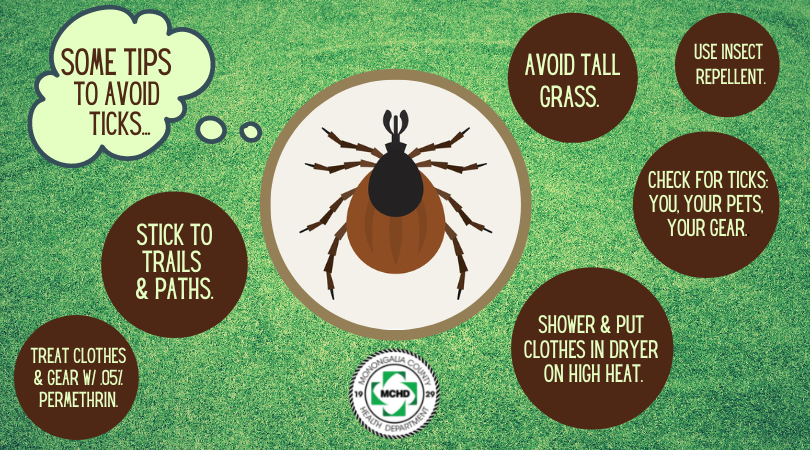Monongalia County sees yes, an uptick in ticks... and Lyme disease

Jun. 9, 2022
By Mary Wade Burnside
Morgantown is surrounded by and full of great walking and hiking trails. Core Arboretum is an easy drive for many residents; Coopers Rock State Forest is nearby and the rail-trail is accessible to just about everyone.
Yes, Monongalia County offers plenty of outdoor activities and opportunities. And that’s why it’s important that everyone also keep this in mind: The rate of Lyme disease — caused by deer ticks — continues to rise exponentially in both this region and the entire state of West Virginia.
In fact, some residents report finding ticks on their dogs after walking around their neighborhoods. And if you have a grassy yard, that’s another place to be cautious.
Monongalia County Health Department staffers had already heard from state sources that the numbers, which were bad last summer, have just gotten worse in 2022.
Just to get an idea, at about this point last year, according to the West Virginia Department of Health and Human Resources’ (DHHR) Zoonotic Disease Group, the state had created 278 Lyme disease investigations, 19 of them in Monongalia County. This year, 466 investigations have been created, and 40 of them are in Mon County.
“It has been worse this year than last,” said Michael L. Abshire, a Zoonotic Disease Group research specialist.
And on Tuesday, the DHHR sent out a press release warning West Virginians to take steps to prevent tick-borne diseases.
Of course, Lyme disease occurs when a black-legged, or “deer” tick, attaches itself to a mammal, such as a human, dog or a deer, and helps itself to the host’s blood. According to the Centers for Disease Control and Prevention, in most cases, the tick must be attached for 36-48 hours before Lyme disease is transmitted.
It seems difficult to believe that someone wouldn’t notice that on themselves, but sometimes individuals don’t know until they see the telltale bull’s-eye mark that they’ve had a dayslong tick encounter.
This is why it’s so important to check yourself and your pets for ticks after coming in from outside, especially if you’ve been in grassy areas or in the woods or on a hiking trail.
And remember, ticks come in a variety of sizes as they move through their stages of life: egg, six-legged larva, eight-legged nymph and adult. Some are the size of a poppyseed, as illustrated by this tick-dragging video we created last year as members of MCHD Threat Preparedness conducted tick dragging as part of our surveillance efforts.
Early symptoms of Lyme disease can be similar to COVID and a lot of other illnesses: Fever, chills, headache, fatigue, muscle and joint aches and swollen lymph nodes may occur in the absence of rash.
Last year, the health department also was contacted by an urgent care physician who was surprised by how many cases of Lyme diseases he was seeing. If you have reason to believe you’ve been exposed to a tick bite, a health-care provider can write a prescription for the antibiotic doxycycline. For those not experiencing symptoms, it can be a one-time dose, whereas those who do can get a longer course of the medication, from 10 to 21 days.
The CDC website offers other information and handy tips on how to enjoy nature safely and prevent tick encounters.
Unfortunately, this is a problem that seems to be growing worse. Reported statewide cases have grown from 289 in 2015 to 1,535 in 2021. According to the National Resources Defense Council, reasons for the uptick in ticks include climate change, suburban development and habitat change that are providing conditions that allow ticks to thrive as well as more opportunities for them to come into contact with humans.
Spending time outdoors is a great way to exercise and have fun. Just remember to take measures before, during and when you return to keep safe from ticks.
Mary Wade Burnside is the public information officer at Monongalia County Health Department.